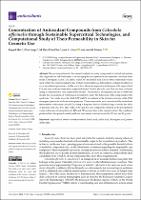Por favor, use este identificador para citar o enlazar este ítem:
https://repositorio.usj.es/handle/123456789/790
Registro completo de metadatos
| Campo DC | Valor | Lengua/Idioma |
|---|---|---|
| dc.contributor.author | Mur, Raquel | - |
| dc.contributor.author | Langa Morales, Elisa | - |
| dc.contributor.author | Pino Otín, Rosa | - |
| dc.contributor.author | Urieta, José Santiago | - |
| dc.contributor.author | Mainar, Ana M. | - |
| dc.date.accessioned | 2022-06-08T12:02:14Z | - |
| dc.date.available | 2022-06-08T12:02:14Z | - |
| dc.date.issued | 2021-12-30 | - |
| dc.identifier.citation | Mur, R.; Langa, E.; Pino-Otín, M.R.; Urieta, J.S.; Mainar, A.M. Concentration of Antioxidant Compounds from Calendula officinalis through Sustainable Supercritical Technologies, and Computational Study of Their Permeability in Skin for Cosmetic Use. Antioxidants 2022, 11, 96. https://doi.org/10.3390/ antiox11010096 | es_ES |
| dc.identifier.issn | 2076-3921 | es_ES |
| dc.identifier.uri | https://repositorio.usj.es/handle/123456789/790 | - |
| dc.description.abstract | The growing interest in the cosmetic industry in using compounds of natural and sustainable origin that are safe for humans is encouraging the development of processes that can satisfy these needs. Chlorogenic acid (CHA), caffeic acid (CAF) and ferulic acid (FA) are three compounds widely used within the cosmetic industry due to their functionalities as antioxidants, collagen modifiers or even as radiation protectors. In this work, two advanced separation techniques with supercritical CO2 are used to obtain these three compounds from Calendula officinalis, and these are then evaluated using a computational skin permeability model. This model is encompassed by the COSMO-RS model, the calculations of which make it possible to study the behaviour of the compounds in the epidermis. The results show that both CAF and FA are retained in the stratum corneum, while CHA manages to penetrate to the stratum spinosum. These compounds were concentrated by antisolvent fractionation with super-critical CO2 using a Response Surface Methodology to study the effect of pressure and CO2 flow rate. CHA, CAF and FA were completely retained in the precipitation vessel, with concentrations between 40% and 70% greater than in the original extract. The conditions predicted that the optimal overall yield and enrichment achieved would be 153 bar and 42 g/min. | es_ES |
| dc.format.extent | 19 p. | es_ES |
| dc.format.mimetype | application/pdf | es_ES |
| dc.language.iso | eng | es_ES |
| dc.publisher | MDPI | es_ES |
| dc.relation | The authors thank to EFA188/16/SPAGYRIA (Este proyecto está cofinanciado por el Fondo Europeo de Desarrollo Regional (FEDER)) and Gobierno de Aragón: Departamento de Ciencia, Universidad y Sociedad del Conocimiento: Group E39_20R. | es_ES |
| dc.rights | Atribución 4.0 Internacional | * |
| dc.rights.uri | http://creativecommons.org/licenses/by/4.0/ | * |
| dc.subject | Supercritical antisolvent fractionation | es_ES |
| dc.subject | Ferulic acid | es_ES |
| dc.subject | Caffeic acid | es_ES |
| dc.subject | Chlorogenic acid | es_ES |
| dc.subject | Permeability skin | es_ES |
| dc.title | Concentration of antioxidant compounds from calendula officinalis through sustainable supercritical technologies, and computational study of their permeability in skin for cosmetic use | es_ES |
| dc.type | info:eu-repo/semantics/article | es_ES |
| dc.identifier.doi | https://doi.org/10.3390/antiox11010096 | es_ES |
| dc.rights.accessrights | info:eu-repo/semantics/openAccess | es_ES |
| Aparece en las colecciones: | Artículos de revistas | |
Ficheros en este ítem:
| Fichero | Descripción | Tamaño | Formato | |
|---|---|---|---|---|
| Concentration of Antioxidant Compounds from Calendula.pdf | 842,11 kB | Adobe PDF |  Visualizar/Abrir |
Este ítem está sujeto a una licencia Creative Commons Licencia Creative Commons

